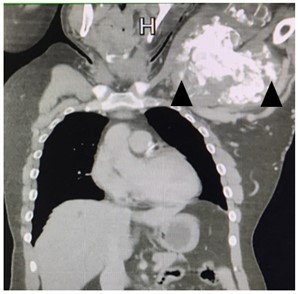A Dialysis Patient with Uremic Tumoral Calcinosis: Treatment with Sodium Thiosulfate
Main Article Content
Abstract
Uremic tumoral calcinosis is a rare complication in patients receiving renal replacement therapy. The condition is associated with high serum calcium and phosphate causing a deposition of calcium mass in various joints in the body. Uremic tumoral calcinosis occurs more commonly among patients with prolonged dialysis vintage. The effect on the musculoskeletal system and the pain causes significant physical impairment and many patients may not be able to continue to work. An in-depth review of published literature suggests that most patients with uremic tumoral calcinosis do not respond to treatment including dietary modification, medications and the change in dialysis prescription. Here, we present a 29-year-old male who has been on maintenance hemodialysis for several years presenting with worsening multiple, nodular, painful, cutaneous swellings of the left shoulder joint over the past three years. The lesions were initially misdiagnosed with tophi that supposedly contained uric acid crystals. He was prescribed high dose of uric acid lowering agent, but the lesions continued to increase in size. Later, the diagnosis of uremic tumoral calcinosis was made based on history, physical examination, imaging, and a confirmation by tissue biopsy. He received multimodality treatment comprising of low dialysate calcium, non-calcium-based phosphate binder and intravenous sodium thiosulfate. After 6 months, the size of the lesions decreased by more than half. The pain also substantially improved in association with the improvement in quality of life.
Article Details

This work is licensed under a Creative Commons Attribution-NonCommercial-NoDerivatives 4.0 International License.
This article is published under CC BY-NC-ND 4.0 license, which allows for non-commercial reuse of the published paper as long as the published paper is fully attributed. Anyone can share (copy and redistribute) the material in any medium or format without having to ask permission from the author or the Nephrology Society of Thailand.
References
Floege J. When man turns to stone: Extraosseous calcification in uremic patients. Kidney Int. 2004;65:2447-62.
Raja DL, Podymow T, Barre T. Tumoral calcinosis in a peritoneal dialysis patient. Kidney Int. 2006;70(11):1887.
Kai MC, Cheuk CS, Angela YM. Uremic tumoral calcinosis. Nephrol Dial Transplant. 2004;19:505-6.
Chakarun CJ, Talkin B, White EA, Miriam R, Philip W. Tumoral calcinosis: sonographic sedimentation sign. J Clin Ultrasound. 2011;39:367-70.
Hamada J, Tamai K, Ono W, Saotome K. Uremic tumoral calcinosis in hemodialysis patients: clinicopathological findings and identification of calcific deposits. J Rheumatol. 2006;33:119–26.
Cofan F, Garcia S, Combalia A, Campistol JM, Oppenheimer F, Ramon R. Uremic tumoral calcinosis inpatients receiving long-term hemodialysis therapy. J Rheumatol. 1999;26:379–85.
Ibels LS. The pathogenesis of metastatic calcification in uremia. Prog Biochem Pharmacol. 1980;17:242–50
Ibrahim M, Kabbaja A, Issouani M, Hassanai A. Tumoral calcinosis: Diffuse multifocal form in hemodialysis patients. Two case reports. Orthop Traumatol Surg Res. 2017;103(5): 815–20.
Guermazi A, Grigoryan M, Cordoliani F, Kerob D. Unusually diffuse idiopathic calcinosis cutis. Clin Rheumatol. 2007;26: 268–70.
Rafaelsen S, Johansson S, Raeder H, Bjerknes R. Long-term clinical outcome and phenotypic variability in hyperphosphatemic familial tumoral calcinosis and hyperphosphatemic hyperostosis syndrome caused by a novel GALNT3 mutation; case report and review of the literature. BMC Genet. 2014;15:98.
Malberti F, Ravani P. The choice of the dialysate calcium concentration in the management of patients on hemodialysis and hemodiafiltration. Nephrol Dial Transplant. 2003;7:37–40.
LeGeros RZ, Contiguglia SR, Alfrey AC. Pathological calcifications associated with uremia: two types of calcium phosphate deposits. Calcif Tissue Res. 1973;13(3);173-85.
Van Straten A, Hoogeveen EK, Khan SHM, Arthur M. Unusual presentation of tumoral calcinosis in chronic renal failure: a case report. Eur J Radiol. 2005;53(2):81-5.
Drueke TB, Touam M, Thorney Brown D, Rostand SG. Extraskeletal calcification in patients with chronic kidney failure. Adv Nephrol. 2000;30:333–56.
Yaerim Kim, Eunah Hwang, Sungbae Park. Case report Resolution of uremic tumoral calcinosis in a patient on peritoneal dialysis with long-term low-calcium dialysate treatment. Kidney Res Clin Pract. 2014;33:226–28.
Aoun A, Baubion E, Banydeen R, Djiconkpode l, Ekindi N, Urena Torres, et al. Incidence and characteristics of calciphylaxis in Martinique (2006–2012). Ann Dermatol Venereol. 2014;141(12):743–9.
Hug I, Gunçaga J. Tumoral calcinosis with sedimentation sign. Br J Radiol. 1974;47(562): 734-6.
Chakarun CJ, Talkin B, White EA, Romero M, Ralls PW. Tumoral calcinosis: sonographic sedimentation sign. J Clin Ultrasound. 2011;39(6):367-70.
Zhen H, Kyung JS, Dillon C, Wing C, Jim S. Imaging features of soft-tissue calcifications and related diseases: A Systematic approach. Korean J Radiol. 2018;19(6):1147-60.
Shen X, Chen W, Wang X, Chen J. Uremic tumoral calcinosis in a patient on hemodialysis. Intern Med. 2012;51(11):1443.
Papadakis JT, Patrikarea A. Sodium thiosulfate in the treatment of tumoral calcifications in a hemodialysis patient without hyperparathyroidism. Nephron 1996; 72:308-12.
Fathi I, Sakr M. Review of tumoral calcinosis: a rare clinicopathological entity. World J Clin Cases. 2014;2:409–14.


